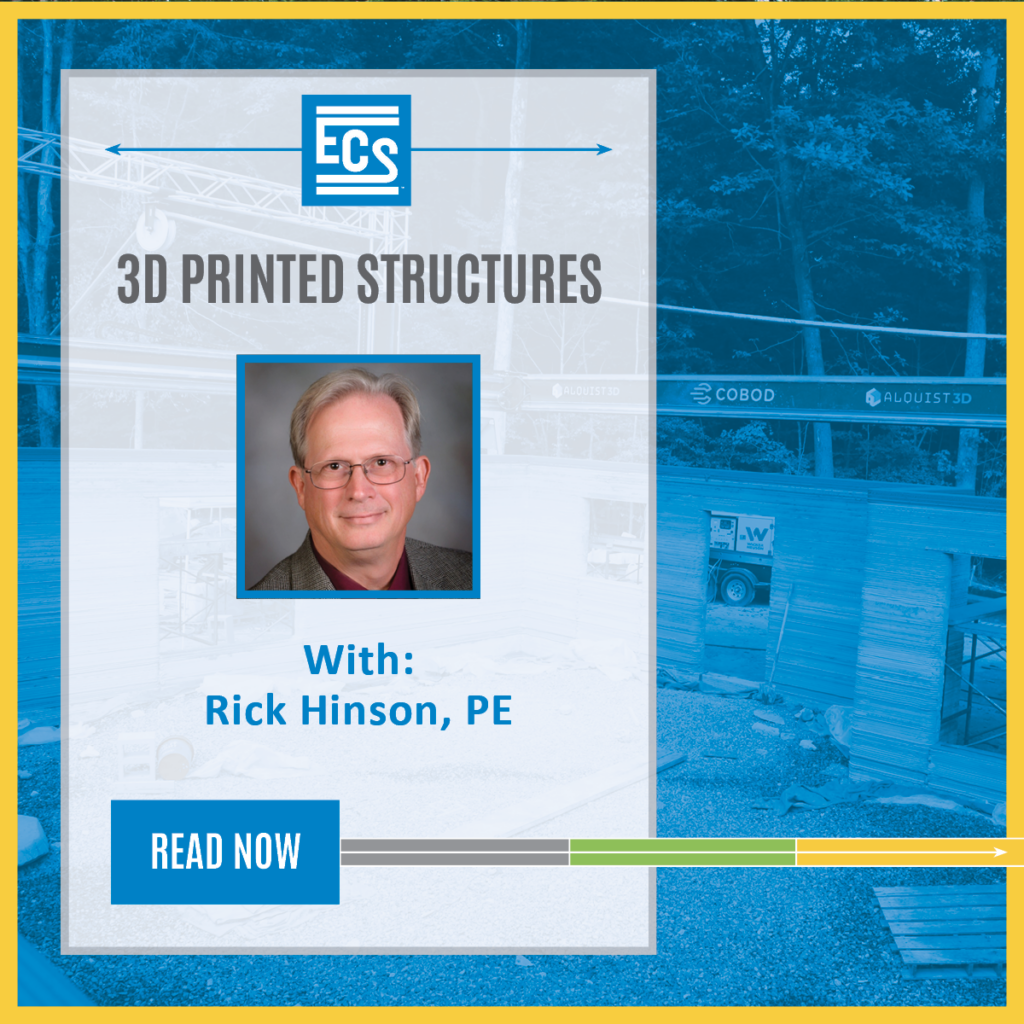By Rick Hinson, PE
3D printed buildings have seen some interest as the costs of construction materials skyrocket, pushing some property owners to seek more affordable, sustainable and unique solutions. As novel as 3D printed structures can be, there are many things to consider, and bringing a materials expert in is essential.
ECS is qualified to advise on code compliance, participate in plan reviews prior to building and avoid costly construction mishaps and delays and ultimately supporting award of the Certificates of Occupancy. Here we’ll define what 3D printing is and its application to the A/E/C industry, its benefits and limitations, and concerns to consider before diving head-first into the business of 3D printed buildings.
What is 3D printing?
The concept of 3D printing is simple enough to understand. With standard printing, a print head with ink jets place ink on a sheet of paper to form an image. 3D printing shares a basic foundation with standard printing. Instead of paper, a stiff and impermeable surface is used, and instead of ink, a semi-solid material similar to toothpaste is used to create a three-dimensional print. The print now has width, length and height.
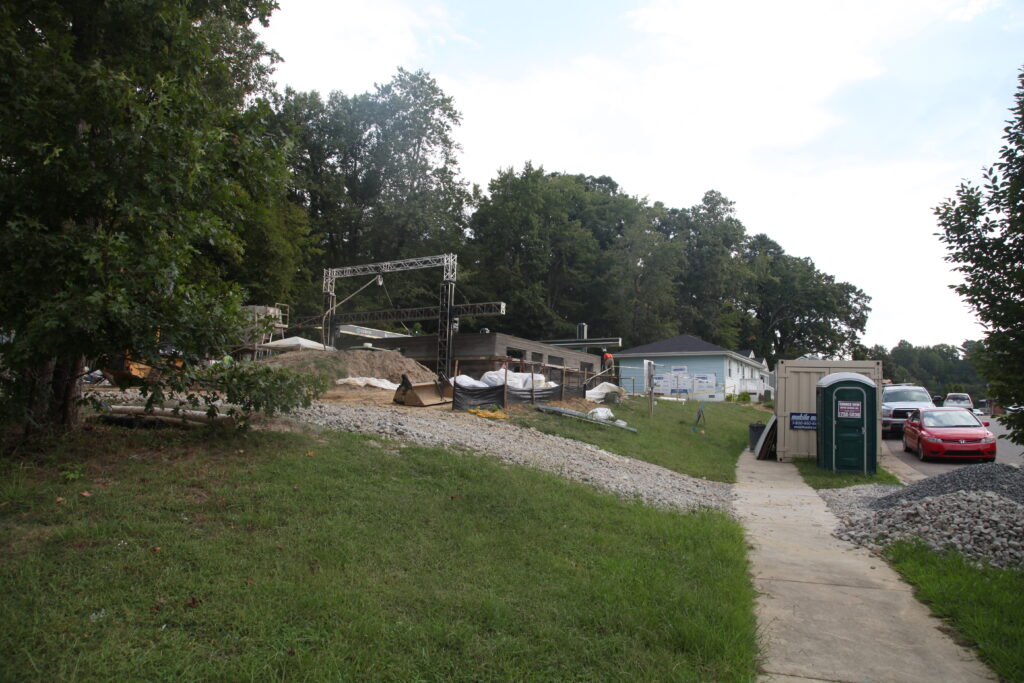 Allowing the first layer to harden, you can raise the print head and add another layer. Do this enough times in layers and you have printed a three-dimensional “thing.”
Allowing the first layer to harden, you can raise the print head and add another layer. Do this enough times in layers and you have printed a three-dimensional “thing.”
Early 3D printing was done on a small scale with plastics, but as the technology and printers got more extensive and complex, it expanded into metals and concrete. In time, someone had the idea to build a “house-sized printer” that extrudes concrete and thus 3D printed construction was born.
Benefits and limitations of 3D printed buildings
At this point, the application is very new and still being evaluated. Keep in mind this is a method of placing concrete. So, the materials are not new; concrete dates back to ancient construction.
The generally accepted theory is that it is fast to build with 3D printed concrete. So, the story goes, simply erect a printer that is larger than the house, building or structure to be built, construct a small concrete mixing plant, dig the footing and foundation and start extruding concrete. Despite all these steps, it might even be faster than a masonry unit or stick-built timber structure. Some purveyors of this construction method also say they can use less concrete than conventional masonry construction.
However, this new concrete placement technique has limitations. From my experience, some printer operators are not entirely familiar with common construction techniques. This lack of familiarity creates some disconnects in what needs to happen to create a structurally sound building from 3D printed concrete. For example, the walls must be “engineered;” they are not standard masonry walls or cast in place concrete walls. Proper engineering is required to ensure the structure can withstand wind, earthquake and gravity loads.
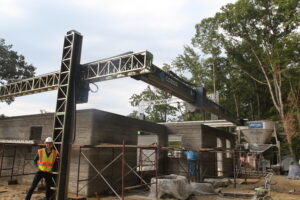 The biggest step is setting up the printer. Think about the size of a house. The printer has to be even larger. It will have at least four legs with two travel rails and a concrete extrusion head that is driven by a computer to travel in three directions. The printer itself must be set and secured or the weight of the concrete and extruder can shift the location of the concrete placement. If that happens, the work must be partially or wholly demolished and the process starts over. This is a waste of a lot of concrete material and time.
The biggest step is setting up the printer. Think about the size of a house. The printer has to be even larger. It will have at least four legs with two travel rails and a concrete extrusion head that is driven by a computer to travel in three directions. The printer itself must be set and secured or the weight of the concrete and extruder can shift the location of the concrete placement. If that happens, the work must be partially or wholly demolished and the process starts over. This is a waste of a lot of concrete material and time.
The 3D printing technique also requires a significant amount of water and constant management of the plasticity of the concrete as it flows through the extruder and flexible piping. Water and temperature must stay within a tight range. If this process is done incorrectly, concrete can harden in the extruder and flexible concrete piping or stay liquid and not remain in layers. This failure will result in project delays and wasted product.
Finally, to complete the project, the building typically still needs a roof, plus mechanical, electrical and plumbing systems. I could go on, but from my experience, several key components and issues still need to be worked out and proven to make 3D printed construction this a mainstream process.
Concerns to consider for 3D printed structures
Because 3D printing structures is relatively new, there are a handful of significant concerns clients should consider when facing the opportunity to use this new technology.
Contracts
According to a 2022 article published by the National Association of Home Builders, there do not appear to be standardized contracts specifically for 3D-printed projects, and experts’ limited experience in 3D printed construction can also lead to challenges when evaluating responsibility for defective work. It can be impossible to determine if the fault was due to the concrete, the printer or some other failure.
Code compliance
It’s worth noting that local, state or national standards have not been developed for 3D-printed buildings. Code compliance requirements will vary depending on location, and it’s reasonable to expect scrutiny from building and code officials.
Concrete expertise
It’s important to hire an expert who specializes in concrete building materials. Concrete cures slowly, and even after it does, it handles moisture very differently than a wood building. Additionally, concrete cracks as it cures. These cracks are typically controlled by designing in joints. When 3D printed, walls may or may not have joints, but they will have cracks. This requires the wall to be sealed or parged after the walls are in place.
It’s also essential to consider resistance design for wind and earthquake loads. Normally, buildings made of concrete are reinforced with steel and perform much better in adverse conditions. A 3D-printed structure might not be steel reinforced, although it can feature lattice, bars, mesh, or fiber.
Comfort and livability
The final look of 3D printed buildings is similar to stacks of pancakes or layers of toothpaste. Often, this is not the desired cosmetic finish, so the walls are often parged or furred out, adding cost.
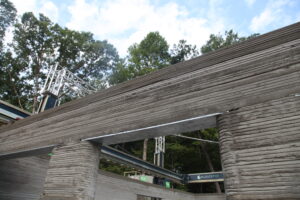 In standard construction, filler is layered inside the wall to maintain a desired temperature year-round. This process is relatively simple to do with interior walls made of plaster or drywall. With 3D printing, however, this process requires that two walls are printed with a gap in between so that insulation can be applied. 3D printed walls are not thin, so this can increase to the overall footprint of the structure, adding costs.
In standard construction, filler is layered inside the wall to maintain a desired temperature year-round. This process is relatively simple to do with interior walls made of plaster or drywall. With 3D printing, however, this process requires that two walls are printed with a gap in between so that insulation can be applied. 3D printed walls are not thin, so this can increase to the overall footprint of the structure, adding costs.
Also, normally the insulation is loose vermiculite filler that will run out if the wall is penetrated inside or outside, and most homeowners will have a challenge getting it back in.
Making changes—such as additions and alterations—to the finished building is very different from standard construction. It will not be as simple as removing and inserting new blocks or framing. To add to a 3D-printed building, a wall placed as a single (or process) assembly will have to be cut away and then the new wall will be married into the existing structure.
Time and expense to build
The 3D printer is often rented equipment, so costs are considerable unless the project receives some form of government grant. But putting aside cost, despite claims, it is not yet clear that extruding concrete is faster than having professional masons place concrete masonry blocks.
Sustainability
The significant amount of water required to produce the concrete material is a drawback, and wood is commonly considered a more sustainable material than concrete because it produces less carbon emissions to manufacture.
Construction-safety considerations
Safety on construction sites is important, but the equipment needed for 3D printing adds new hazards for crew members to be aware of. Staff must take care when working around the printer’s overhead gantry system and moving concrete pipe and extruder. These elements can result in struck-by incidents. Also, moving the 3D printer safely between sites is difficult and introduces safety hazards on the road.
The future of 3D printing
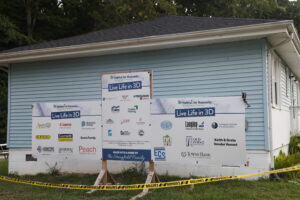 A limited number of construction firms have ventured into the 3D printed construction space, leaving plenty of room for growth. However, the use of 3D printing in the A/E/C industry requires significant refinement. Engineering is still required to address load and support capacity, moisture control over the life of the structure and any necessary changes to heating/cooling and ventilation systems to account for the impact of curing concrete and how concrete functions in wet versus dry environments.
A limited number of construction firms have ventured into the 3D printed construction space, leaving plenty of room for growth. However, the use of 3D printing in the A/E/C industry requires significant refinement. Engineering is still required to address load and support capacity, moisture control over the life of the structure and any necessary changes to heating/cooling and ventilation systems to account for the impact of curing concrete and how concrete functions in wet versus dry environments.
Involving a qualified engineer during the planning and construction phases, as well as any post-construction repairs and modifications, will go a long way in ensuring the viability, longevity of these buildings for occupancy. Contact us to discuss your 3D printed building goals.
About the Author
William Rick Hinson, PE, is a principal engineer from our Mid-Atlantic Christiansburg, VA, office. He specializes in code compliance plan review, construction administration, special inspection services, lectures, instruction and management.

